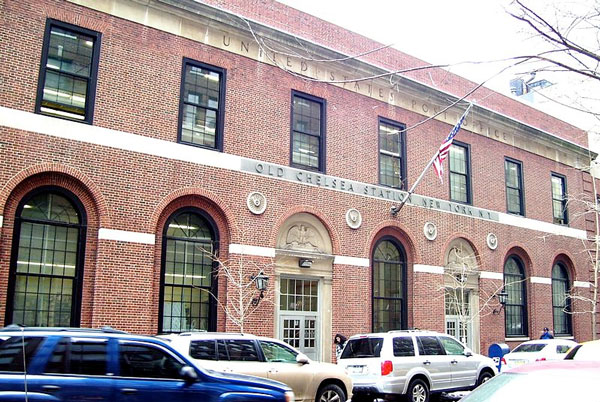BY LIZA BéAR | On Jan. 22, while at the Old Chelsea Station to return a package ordered online, Village resident Barbara Ruether, 79, noticed a two-page letter pinned to the wall in the entrance that referred to the proposed sale of the historic building. A few days later she acquired a PDF digital copy of the letter, plus the preservation covenant attached to it, and circulated it widely via e-mail to neighbors and local officials, who had not been notified previously.
After fighting to stop the closure of St Vincent’s Hospital, where she worked for 35 years in the Department of Community Medicine, Ruether said that with the potential loss of another neighborhood fixture, “life was dissolving around her.”
Old Chelsea Station, at 217 W. 18th St., is a two-story, red brick, limestone-trimmed, Colonial Revival-style structure built in 1937 under F.D.R.’s New Deal. The building is amply proportioned at 41,865 square feet. Its lobby retains green and buff marble floor and full-height pilasters, as well as the deer and bear relief panels carved by Paul Fiene. It’s one of 29 Depression-era post offices in New York City.
Dated Jan. 14, the letter, addressed to the Historic Preservation Field Services Bureau at the New York State Office of Parks, Recreations and Historic Preservation, is to date the sole public reference of the sale — and of a 30-day public comment period, which expires Feb. 11, regarding possible adverse effects.
Even Chuck Zlatkin, legislative and political director of the New York Metro Area Postal Union (APWU, AFL-CIO), who lives a few blocks away from Old Chelsea Station, said that he learned of the intended sale only a few days ago and that the union had not been notified.
“This is endemic,” said Zlatkin on the phone. “Every time they do something, they keep it hidden. They didn’t contact the union or the community directly. It’s unacceptable. But they claim that’s all they’re required to do.”
In its ongoing march toward privatization and deficit-reduction, the United States Postal Service has sold at least a dozen historic post offices nationally in the past year. Locally, protests by postal workers and supporters are being held on Feb. 6 against the sale of the Bronx processing and sorting facility, and on Feb. 9 against the pending closure of the Staten Island processing plant, which will impact services throughout the area.
In an e-mailed statement in response to questions, Congressmember Jerrold Nadler urged U.S.P.S. “to keep its station at the Old Chelsea Post Office and to maintain all of the services currently available, without any reductions.
“This post office is heavily used and provides a critical service to Chelsea residents,” he wrote, “many of whom are seniors or otherwise unable to travel far to conduct postal services. I am also distressed by the absence of clarity or transparency by the U.S.P.S. surrounding the sale of its Chelsea property. We should not learn of an impending sale and closure only through a letter to the state agency on historic preservation. Along with the Chelsea community and elected officials, I am asking U.S.P.S. to reconsider its closure of the Old Chelsea Post Office and to engage in a public dialogue on its plans.”
Community Board 4 is taking up the issue at its full board meeting on Feb. 6, according to District Manager Robert Benfatto, who said that most likely C.B. 4 will authorize a letter to U.S.P.S. detailing “the importance of an up-and-running post office staffed by people in Chelsea, the importance of the building they presently use, the importance of an open and transparent process, and the importance of clear information to keep the community well-informed.”
In addition to the Prince St. Station (sold to Apple), recent post office closures in Manhattan include Tudor City Station, Dag Hammarskjöld Station and Empire Station, each of which has been replaced with an automated postal center; in the Bronx, Van Nest Station, Crotona Park Station and Oak Point Station; in Queens, La Guardia Airport Station in Flushing and the parcel post annex in Long Island City.
Reached by phone in Tampa, Florida, and asked for clarification, Ann M. Yarnell, the Postal Service’s facilities environmental specialist, and the author of the U.S.P.S. letter, aware of the concern and confusion in the Chelsea community, gave her account of what happened. It appears that her letter, regarding historical landmark issues only, was —contrary to standard procedure — sent out before the normal notification letter regarding the actual sale of the building. The latter is due to be sent in the next week or so.
For confirmation of the exact date, Yarnell referred questions to Joseph J. Mulvey, U.S.P.S. real estate specialist for the region who would be writing that letter. However, on his cell phone in Massachusetts, Mulvey said that he could not answer questions from the news media and that he would forward the request to Congetta Chirichello at U.S.P.S. corporate communications, but that he could not guarantee that she would contact him for his answers.
At press time, Chirichello had not responded.
An earlier version of this article incorrectly stated that the Old Chelsea Station post office was a landmarked building. No part of it is landmarked, neither the exterior or the interior, according to the city’s Landmarks Preservation Commission. However, the building is on the National Register of Historic Places.


















